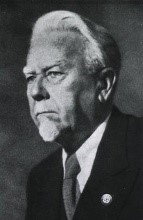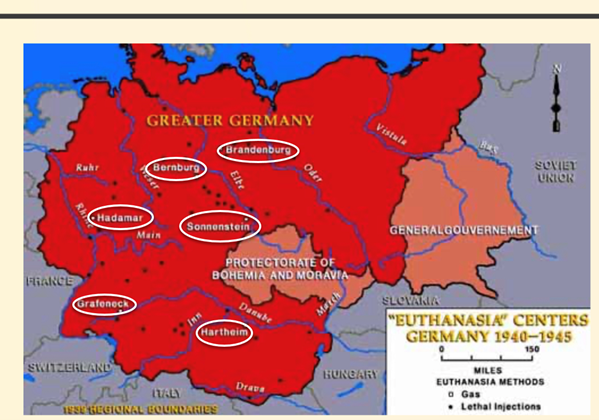At The Project Gideon Company it is our opinion that the role of the psychiatric industry has long been misunderstood and underrated as one of the root causes of the Holocaust.
Category: Psychiatry
Definitions
Eugenics
The study of how to arrange reproduction within a human population to increase the occurrence of heritable characteristics regarded as desirable.
Evolution
The gradual development of something, especially from a simple to a more complex form.
Euthanasia
An easy or painless death, or the intentional ending of the life of a person suffering from an incurable or painful disease at his or her request. Also called mercy killing.
NCI Dictionary of Cancer Terms
Racial Hygiene
The term racial hygiene was used to describe an approach to eugenics in the early 20th century. Most eugenicists at the time, racial hygienists believed that the lack of eugenics would lead to rapid social degeneration, the decline of civilization by the spread of inferior characteristics.
Eugenics
Eugenics is the scientifically erroneous and immoral theory of “racial improvement” and “planned breeding,” which gained popularity during the early 20th century. Eugenicists worldwide believed that they could perfect human beings and eliminate so-called social ills through genetics and heredity. They believed the use of methods such as involuntary sterilization, segregation and social exclusion would rid society of individuals deemed by them to be unfit.
The eugenics movement started long before the Holocaust and continued long after. The eugenics movement in Germany, and during the Holocaust took a particularly dark, outright proactive, turn. [Author’s note: I doubt if there were any “light” turns in this movement.]
In any discussion of eugenics, the terms unfit and undesirable constantly appear. Upon examination, these appear to be political rather than scientific definitions, which of course means that the definitions keep changing. It can be said that the Pharaohs practiced eugenics in Exodus by drowning Jewish infants. The Chinese practiced eugenics by killing (or more recently aborting) female children. More recently, in the 20th century, eugenics came to mean sterilization.
The Nazis of course carried this to extremes and performed outright killings.
The Personalities

An American lawyer, anthropologist, writer, and zoologist known primarily for his work as a eugenicist and conservationist, an advocate of scientific racism, and as one of the leading thinkers and activists of the Progressive Era.
Grant’s work was embraced by proponents of the National Socialist movement in Germany and was the first non-German book ordered to be reprinted by the Nazis when they took power. Adolf Hitler wrote to Grant, “The book is my Bible.” At the postwar Nuremberg Trials, three pages of excerpts from Grant’s Passing of the Great Race were introduced into evidence by the defense of Karl Brandt, Hitler’s personal physician and head of the Nazi euthanasia program, in order to justify the population policies of the Third Reich, or at least indicate that they were not ideologically unique to Nazi Germany

This man may be the key to the whole puzzle of the magnitude of the Holocaust. Born in 1893, a renowned psychiatrist and a major advocate of the idea that the German race was becoming “polluted”[1]
At a conference on alcoholism in 1903, he argued for the sterilization of ‘incurable alcoholics’, but his proposal was roundly defeated. In 1904, he was appointed co-editor in chief of the newly founded Archive for Racial Hygiene and Social Biology, and in 1905 was among the co-founders of the German Society for Racial Hygiene (which soon became international). He published an article of his own in Archives in 1910, in which he argued that medical care for the mentally ill, alcoholics, epileptics and others was a distortion of natural laws of natural selection, and medicine should help to clean the genetic pool.
Perhaps his personality and views are best summarized by the following quote:
In 1942, speaking about ‘euthanasia’, Rüdin emphasized “the value of eliminating young children of clearly inferior quality”.
This was a psychiatrist and a racist and a strong advocate of euthanasia of “inferiors”. He joined the Nazi party in 1937, and for Rüdin and Hitler, it was love at first sight.
Rüdin gave Hitler something he craved, a scientific basis for his beliefs. Hitler gave Rüdin what he needed, funding to implement his ideas. This was the perfect storm. Shortly thereafter “euthanasia centers” (see section 4 below) began to appear throughout Germany.
One could easily nominate Rüdin as “The Father of the Holocaust”.

Alfred Ploetz (22 August 1860 – 20 March 1940) was a German physician, biologist, Social Darwinist, and eugenicist known for coining the term racial hygiene (Rassenhygiene), a form of eugenics, and for promoting the concept in Germany.
Ploetz wrote in April 1933 that year that he believed that Hitler would bring racial hygiene from its previous marginality into the mainstream.
Euthanasia Centers
In 1939, with Hitler’s financial backing, a series of “euthanasia centers” began to appear.
Beginning in the fall of 1939, gassing installations were established at Bernburg, Brandenburg, Grafeneck, Hadamar, Hartheim, and Sonnenstein. Patients were selected by doctors and transferred from clinics to one of these centralized gassing installations and killed.
These “euthanasia centers” were widespread throughout Germany.
On January 9, [1939] the first “gassing test” using carbon monoxide took place in the Brandenburg sanitarium. Between 18 and 20 people were killed, watched by psychiatrists, physicians, and nurses. In 1941, the psychiatric institution at Hadamar celebrated the cremation of its 10,000th patient where everyone—secretaries, nurses, and psychiatrists—received a bottle of beer for the occasion.

It was at these centers that the prototype for the mass killings was developed. The “patients” were gassed, and bodies cremated.
| T4 Center | Operation timetable | Number of victims |
| T4 Center | From | Total |
| Grafeneck | 20 January 1940 | 9,839 |
| Brandenburg | 8 February 1940 | 9,772 |
| Bernburg | 21 November 1940 | 8,601 |
| Hartheim | 6 May 1940 | 18,269 |
| Sonnenstein | June 1940 | 13,720 |
| Hadamar | January 1941 | 10,072 |
| Total | 70,273 |
It is important to note that this was almost three years before the first mass killing facility, Chemlo, went into operation. When Chemlo went into operation, the killing became an industry.
Tiergartenstrasse 4 – Aktion T4
No discussion of the Holocaust is complete without a discussion of Aktion T4. Many consider Aktion T4 to be the dress rehearsal for the Holocaust.
The [T4] Euthanasia Program represented in many ways a rehearsal for Nazi Germany’s subsequent genocidal policies. The Nazi leadership extended the ideological justification conceived by medical perpetrators for the destruction of the “unfit” to other categories of perceived biological enemies, most notably to Jews and Roma (Gypsies).
Planners of the “Final Solution” later borrowed the gas chamber and accompanying crematoria, specifically designed for the T4 campaign, to murder Jews in German-occupied Europe. T4 personnel who had shown themselves reliable in this first mass murder program figured prominently among the German staff stationed at the Operation Reinhard killing centers of Belzec, Sobibor, and Treblinka.
The description of the operation of Aktion T4 bears an uncomfortable resemblance to an Orwellian novel.
Beginning in October 1939, public health authorities began to encourage parents of children with disabilities to admit their young children to one of a number of specially designated pediatric clinics throughout Germany and Austria. In reality, the clinics were children’s killing wards. There, specially recruited medical staff, murdered their young charges by lethal overdoses of medication or by starvation.
There is not much more to say about this. It was methodical, cold blooded and efficient, and, under guidance of medical professions It grew into the Holocaust.
Why the Silence?
After the end of World War 2, as the Nuremberg trials began, a large number of psychiatrists were due to stand trial. The American Psychiatric Association feared that because of the actions of these psychiatrists the profession would carry a permanent black mark, so pressure was applied to minimize the number of psychiatric defendants.
The involvement of Ernst Rüdin was thoroughly whitewashed. Three types of accounts have been identified:
- Those who write about German psychiatric genetics in the Nazi period, but either fail to mention Rüdin at all, or cast him in a favorable light
- Those who acknowledge that Rüdin helped promote eugenic sterilization and/or may have worked with the Nazis, but generally paint a positive picture of Rüdin’s research and fail to mention his participation in the “euthanasia” killing program
- Those who have written that Rüdin committed and supported unspeakable atrocities.”
After the war, the German Medical Association blamed Nazi atrocities on a small group of 350 criminal doctors.[1] It was not until the 21st century that the truth started to appear.
And let us never forget how massive these events were and it is easy to miss details, even significant details.
“
Some Quotes
From the website of the German psychiatric association.
Without the initiative and support of psychiatrists and other doctors, the national socialist „euthanasia“ programme could not have been implemented.”
*German Association for Psychiatry,Psychotherapy and Psychosomatics
-DGPPN Website
In 2010, Schneider, then president of the DGPPN*, formally asked the victims of the Nazi era and their families for “forgiveness for the pain and injustice [they] suffered in the name of German psychiatry and at the hands of German psychiatrists under National Socialism, and for the silence, trivialization, and denial that for far too long characterized psychiatry in post-war Germany.
Investigative journalist Victor H. Bernstein stated: “I am sure that Prof. Rüdin never so much as killed a fly in his 74 years. I am also sure he is one of the most evil men in Germany.”